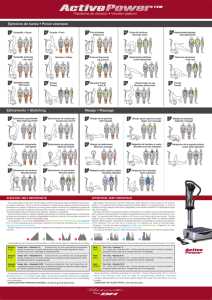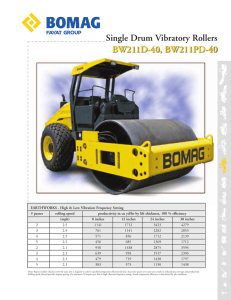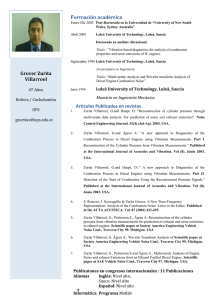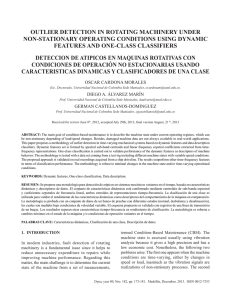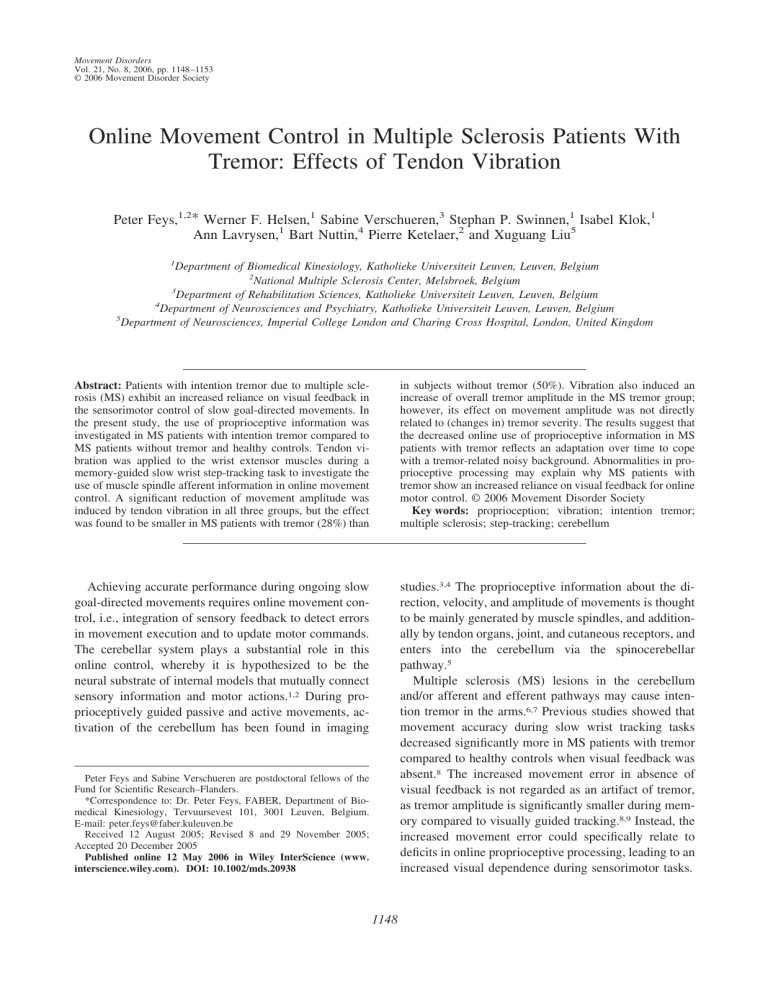
Movement Disorders Vol. 21, No. 8, 2006, pp. 1148 –1153 © 2006 Movement Disorder Society Online Movement Control in Multiple Sclerosis Patients With Tremor: Effects of Tendon Vibration Peter Feys,1,2* Werner F. Helsen,1 Sabine Verschueren,3 Stephan P. Swinnen,1 Isabel Klok,1 Ann Lavrysen,1 Bart Nuttin,4 Pierre Ketelaer,2 and Xuguang Liu5 1 Department of Biomedical Kinesiology, Katholieke Universiteit Leuven, Leuven, Belgium 2 National Multiple Sclerosis Center, Melsbroek, Belgium 3 Department of Rehabilitation Sciences, Katholieke Universiteit Leuven, Leuven, Belgium 4 Department of Neurosciences and Psychiatry, Katholieke Universiteit Leuven, Leuven, Belgium 5 Department of Neurosciences, Imperial College London and Charing Cross Hospital, London, United Kingdom Abstract: Patients with intention tremor due to multiple sclerosis (MS) exhibit an increased reliance on visual feedback in the sensorimotor control of slow goal-directed movements. In the present study, the use of proprioceptive information was investigated in MS patients with intention tremor compared to MS patients without tremor and healthy controls. Tendon vibration was applied to the wrist extensor muscles during a memory-guided slow wrist step-tracking task to investigate the use of muscle spindle afferent information in online movement control. A significant reduction of movement amplitude was induced by tendon vibration in all three groups, but the effect was found to be smaller in MS patients with tremor (28%) than in subjects without tremor (50%). Vibration also induced an increase of overall tremor amplitude in the MS tremor group; however, its effect on movement amplitude was not directly related to (changes in) tremor severity. The results suggest that the decreased online use of proprioceptive information in MS patients with tremor reflects an adaptation over time to cope with a tremor-related noisy background. Abnormalities in proprioceptive processing may explain why MS patients with tremor show an increased reliance on visual feedback for online motor control. © 2006 Movement Disorder Society Key words: proprioception; vibration; intention tremor; multiple sclerosis; step-tracking; cerebellum Achieving accurate performance during ongoing slow goal-directed movements requires online movement control, i.e., integration of sensory feedback to detect errors in movement execution and to update motor commands. The cerebellar system plays a substantial role in this online control, whereby it is hypothesized to be the neural substrate of internal models that mutually connect sensory information and motor actions.1,2 During proprioceptively guided passive and active movements, activation of the cerebellum has been found in imaging studies.3,4 The proprioceptive information about the direction, velocity, and amplitude of movements is thought to be mainly generated by muscle spindles, and additionally by tendon organs, joint, and cutaneous receptors, and enters into the cerebellum via the spinocerebellar pathway.5 Multiple sclerosis (MS) lesions in the cerebellum and/or afferent and efferent pathways may cause intention tremor in the arms.6,7 Previous studies showed that movement accuracy during slow wrist tracking tasks decreased significantly more in MS patients with tremor compared to healthy controls when visual feedback was absent.8 The increased movement error in absence of visual feedback is not regarded as an artifact of tremor, as tremor amplitude is significantly smaller during memory compared to visually guided tracking.8,9 Instead, the increased movement error could specifically relate to deficits in online proprioceptive processing, leading to an increased visual dependence during sensorimotor tasks. Peter Feys and Sabine Verschueren are postdoctoral fellows of the Fund for Scientific Research–Flanders. *Correspondence to: Dr. Peter Feys, FABER, Department of Biomedical Kinesiology, Tervuursevest 101, 3001 Leuven, Belgium. E-mail: [email protected] Received 12 August 2005; Revised 8 and 29 November 2005; Accepted 20 December 2005 Published online 12 May 2006 in Wiley InterScience (www. interscience.wiley.com). DOI: 10.1002/mds.20938 1148 TENDON VIBRATION IN MS TREMOR PATIENTS To investigate the online use of proprioceptive afferences in MS patients with tremor, tendon vibration was applied to the wrist extensor muscles during the performance of a memory-guided wrist step-tracking task. Tendon vibration is a strong stimulator of muscle spindle afferents, thereby biasing the information about muscle length, resulting in predictable movement illusions. During memory-guided movements, tendon vibration typically leads to a reduction of movement amplitude and/or target undershoot.10 To differentiate the effects caused by tremor and the disease of MS, MS patients with tremor were compared with MS patients without tremor and healthy controls. PATIENTS AND METHODS Patients With Multiple Sclerosis and Healthy Controls MS patients with and without intention tremor were selected by neurologists of the Belgian National MS Center. Intention tremor severity was rated during the finger-to-nose test and spirography according to Fahn’s tremor rating scale.11 Arms showing spasticity, muscle paresis, or sensory loss during the clinical neurological examination were excluded. To document relevant impairment and overall disability of the MS patient groups, ratings of the functional systems (pyramidal, cerebellar, and sensory) and the Expanded Disability Status Scale (EDSS) were obtained from the medical files.12 MS patients were divided into an MS tremor group (34 tremuleous arms in 20 patients; 11 men, 9 women; mean age, 50.9 ⫾ 10.4 years) and an MS no-tremor group (30 arms in 19 patients; 9 men, 10 women; mean age, 53.5 ⫾ 12.8 years). The clinical characteristics of both MS groups are summarized in Table 1. The control group consisted of 32 arms in 16 healthy subjects without known neurological deficits (7 men, 9 women; mean age, 45.9 ⫾ 10.3 years). MS patients with and without tremor were compared to the healthy control group to differentiate possible general MS-related differences from specific dysfunctions due to the presence of intention tremor. All subjects signed an informed consent prior to participation in the study, which was conducted in accordance with the ethical standards laid down in the 1964 Declaration of Helsinki and approved by the local ethics committee. Step-Tracking Task and Tendon Vibration The step-tracking task was previously described in detail and is summarized here.8,13 Subjects sat in front of a computer screen with an orthosis applied to the forearm 1149 and hand, allowing wrist flexion and extension movements. A wooden panel prevented direct sight of the wrist angular position. Wrist movements were recorded at a sampling rate of 200 Hz by means of an angle encoder and displayed on the screen as an unfilled circle. Two stationary targets were horizontally placed 200 mm apart. This intertarget distance corresponded to a wrist displacement of 40°. Participants had to make discrete movements between the targets respecting a rhythmical pattern of 0.20 Hz provided by a metronome. In response to each beep, the participant was instructed to initiate the subsequent movement to the alternative target. Vibration (70 Hz; peak-to-peak amplitude of 1 mm) was applied to the tendons of the wrist extensor muscles by means of a cylindrical vibrator (Dynatronic; vibrateurs proprioceptive: VB100). The vibrator probe (weight, 100 g; length, 7 cm; width, 3 cm) was fixed dorsally and 1 cm proximally of the radial and ulnar epicondyles and left in place throughout the experiment. Test Procedure To familiarize with the temporal and spatial constraints of the step-tracking task, three blocks consisting of 17 movements were performed with the eyes open and with visual feedback of targets and cursor. Afterward, subjects were trained to step-track with the eyes closed during three blocks. To enable the subjects to start each block with an accurate performance, visual display of target and cursor was presented during the first five step-tracking movements. After these, neither target nor cursor positions were presented on the visual display while subjects were explicitly instructed to close their eyes and to concentrate on the required wrist movement. Their performance was replayed on the screen to stimulate internalization of the required movement. After this training, subjects alternatively performed memory-guided step-tracking under “no vibration” and ”tendon vibration” conditions. After each “tendon vibration” condition, a washout block was added to dissipate possible aftereffects induced by the preceding vibration. After both the no vibration and washout blocks, tracking performance was replayed on the visual display while the researcher commented on movement accuracy. This feedback moment was intended to make the subjects maintain tracking accuracy throughout the test session. Summarized, three test blocks each consisting of 12 memory-guided tracking movements were recorded in each condition. The first two movements of each block were excluded for data analysis to allow tendon vibration to reach a maximal effect. The tracking performance of left and right hands was tested separately in a random order among subjects. Movement Disorders, Vol. 21, No. 8, 2006 1150 P. FEYS ET AL. TABLE 1. Clinical characteristics of the MS tremor and the MS no tremor group MS tremor group 1 2 3 4 5 6 7 8 9 10 11 12 13 14 15 16 17 18 19 20 MS no-tremor group 1 2 3 4 5 6 7 8 9 10 11 12 13 14 15 16 17 18 19 Finger-to-nose test* Spirography Type of MS MS duration (yr) EDSS SP PP SP PP RR RR RR SP PP PP RR RR PP RR PP PP PP RR SP SP 18 3 28 3 17 17 8 24 12 22 3 25 36 15 12 14 13 20 19 3 6 6 6.5 6 6.5 6.5 8 7 6 8 7 6.5 6.5 6 8 6 6 6 7 6 1 1 2 2 2 3 2 2 3 1 1 1 3 3 1 3 2 1 1 0 2 1 2 1 1 1 1 4 2 1 1 2 4 1 2 4 2 0 0 2 2 1 2 2 2 4 3 2 3 3 0 3 2 1 2 1 2 1 1 2 2 2 3 1 1 3 1 4 1 2 0 4 4 1 2 4 1 0 0 4 RR PP SP PP RR RR RR SP SP PP PP SP PP SP RR SP PP SP SP 9 23 17 56 16 7 22 18 32 18 16 7 11 9 11 22 34 10 18 6 6.5 6.5 6 5 6 6 6.5 7 6.5 6.5 6 6.5 6.5 5 6.5 6 6.5 6 0 0 0 0 0 0 0 1 0 N N 0 0 0 0 0 0 0 1 0 0 0 0 0 0 0 0 0 0 0 0 0 0 0 0 0 0 0 0 0 0 0 2 0 0 0 1 N N 0 1 1 0 1 0 0 0 0 0 0 0 0 0 0 0 0 0 0 0 0 0 0 0 0 0 0 L R L R *0, none; 1, slight; 2, moderate; 3, marked; 4, severe tremor amplitude. RR, relapsing remitting; PP, primary progressive; SP, secondary progressive; N, no ratings due to severe paresis of the arm. Data Processing and Statistical Analysis Three arms tested in the MS tremor group were further excluded from data analysis because of failing in performing the task due to severe tremor (two) and a painful sensation during tendon vibration (one). As such, the MS tremor, MS no tremor, and control groups consisted of 31, 30, and 32 arms, respectively. The raw position data were filtered using a secondorder Butterworth filter with low-pass cutoff frequency of 10 Hz. The start of a movement was defined as the time at which wrist velocity first exceeded 50 mm/s. The end of each movement corresponded to the start of the Movement Disorders, Vol. 21, No. 8, 2006 next movement. Two spatial variables were analyzed: movement amplitude and additional path length. Movement amplitude was defined as the distance between the wrist position at the start and the end of each movement. Additional path length was calculated as the difference between the trajectory covered during the movement trial and the straight distance between the start and end position of the wrist. The additional path length correlates significantly with intention tremor amplitude.8 To investigate possible differences between the clinical characteristics of the MS tremor group and the MS no tremor group, the unpaired t test was used for examina- TENDON VIBRATION IN MS TREMOR PATIENTS 1151 FIG. 1. Illustrations of movement trials of cases representative for the (A) healthy control, (B) MS no tremor, and (C) MS tremor groups in the no vibration and tendon vibration conditions. Target positions were set at ⫹100 and ⫺100 mm. tion of the age and disease duration, the 2 test for examination of type of MS, handedness, and male-tofemale ratio, and the Mann–Whitney U test for examination of measures of impairment (pyramidal, cerebellar, and sensory functional system) and overall disability (EDSS). Separate 3 ⫻ 2 (group ⫻ condition) ANOVAs were carried out for movement amplitude and additional path length. Group consisted of the MS patient group, MS no tremor group, and the healthy control group. Condition referred to the no vibration and tendon vibration conditions. Pearson correlation coefficients were calculated where appropriate. Bonferonni–Dunn posthoc tests were used to correct for multiple comparisons. The level of significance was set at P ⬍ 0.05. RESULTS The MS tremor and MS no tremor groups did not differ significantly regarding age (t ⫽ 0.99; P ⫽ 0.32), male-to-female ratio (2 ⫽ 0.38; P ⫽ 0.53), type of MS (2 ⫽ 1.2; P ⫽ 0.52), and disease duration (t ⫽ 0.55; P ⫽ 0.57). In addition, no differences were found in EDSS (Z ⫽ ⫺0.67; P ⫽ 0.49), pyramidal (Z ⫽ ⫺0.36; P ⫽ 0.71), or sensory function (Z ⫽ ⫺0.23; P ⫽ 0.81). As expected, the median functional score on the cerebellar system, which rates the severity of ataxia, was significantly greater (Z ⫽ ⫺5.29; P ⬍ 0.0001) in the MS tremor (2.5) than in the MS no tremor group (0), suggesting that intention tremor as discriminating symptom between both groups was likely linked to cerebellar dysfunction. The step-tracking performance during the no vibration and tendon vibration conditions of representative subjects of the healthy control, the MS no tremor, and the MS tremor groups is illustrated in Figure 1. In all groups, tendon vibration resulted in a significant reduction of movement amplitude (F(1,90) ⫽ 841.8; P ⬍ 0.0001). However, the reduction was smaller in the MS tremor group than in the MS no tremor and healthy control groups (group ⫻ condition interaction, F(2,90) ⫽ 24.5; P ⬍ 0.0001; Fig. 2). In both no vibration and tendon vibration conditions, movement amplitude was significantly larger in the MS tremor group compared with the MS no tremor and healthy control groups (F(2,90) ⫽ 22.5; P ⬍ 0.0001). When expressing movement amplitude in the tendon vibration condition as a percentage of the value in the no vibration condition, a mean reduction of nearly 50% was found in the MS no tremor and healthy control groups, whereas the reduction was only 28% in the MS tremor group. Within the MS tremor group, no significant correlations were found between the vibration-induced reduction of movement amplitude and tremor severity, reflected by the additional path length, in the no vibration and tendon vibration conditions. This finding indicates that tendon vibration induced a similar movement illusion in both MS patients with mild and severe tremor. A significant increase in additional path length was found in the tendon vibration condition (MS tremor, 96.6 mm; MS no tremor, 13.3 mm; healthy control, 9 mm) as compared to the no vibration condition (MS tremor, 47.8 Movement Disorders, Vol. 21, No. 8, 2006 1152 P. FEYS ET AL. FIG. 2. The mean movement amplitude (and SD) in the no vibration and tendon vibration conditions for control, MS no tremor, and MS tremor groups. The intertarget distance was 200 mm. mm; MS no tremor, 5.9 mm; healthy control, 3 mm; F(1,90) ⫽ 13.7; P ⬍ 0.001). The difference between both conditions was obviously more pronounced in the MS tremor group than in the MS no tremor and healthy control groups (group ⫻ condition interaction, F(2,90) ⫽ 6.0; P ⬍ 0.01). These findings indicate that tremor amplitude increased when tendon vibration was applied. Within the MS tremor group, two subgroups were made based on the change in tremor severity between the no vibration and tendon vibration conditions. The additional path length remained unchanged or even decreased in 7 tremor arms, while an increase was observed after tendon vibration in 24 tremor arms. The additional path length of both subgroups was not significantly different in the no vibration condition, while in the tendon vibration condition, it was obviously greater in the subgroup with increased tremor compared to the subgroup without tremor increase (P ⬍ 0.01; Fig. 3A). The movement amplitude was not different between the subgroups, neither in the no vibration nor in the tendon vibration condition (Fig. 3B), indicating a similar vibration effect in both subgroups. The findings suggest that (changes in) tremor severity did not significantly influence the vibration-induced movement illusion. DISCUSSION This study investigated the online processing of muscle spindle afferences during slow step-tracking. MS patients without tremor in the upper limb behaved very similarly to healthy controls during memory-guided steptracking, during conditions both with and without tendon vibration. Clinical characteristics such as age and scores on the pyramidal and sensory functional system were not significantly different between the MS patients without and with arm tremor except for the cerebellar system. Therefore, we believe that the different tracking performance in MS patients with tremor is specifically related to the symptom of intention tremor and not to general MS pathology. Movement Disorders, Vol. 21, No. 8, 2006 The amplitude of the performed movement in MS patients with tremor was significantly greater than the required displacement, and than that performed by MS patients without tremor and healthy controls, consistent with previous research.8 Vibration of the wrist extensors induced a significant reduction in movement amplitude with an increase in variability across all groups. This strongly suggests that the muscle spindle afferent information was effectively modified by vibration and used for the online control of the memory-guided slow steptracking movements. One of the major findings of the present study is that the vibration-induced decrease of movement amplitude was significantly smaller in the MS tremor group than in the control groups without tremor. This differential vibration effect may be due to the symptomatic presence of intention tremor as its oscillating movements may have induced excessive activation of both wrist flexor and extensor muscle spindles. Accordingly, the vibration-induced movement illusion may be smaller in the presence of tremor because of a smaller mismatch between the amount of afferent information during conditions with and without vibration. However, further data analyses within the MS tremor group showed no relation between (changes in) tremor severity and the effect of tendon vibration on movement amplitude. In addition, previous work in patients with essential tremor also showed a decreased movement illusion during vibration compared to healthy controls when tremor did not occur.14 These findings suggest that the decreased effect of vibration on movement amplitude in MS patients with tremor is not related to the instant presence of FIG. 3. The mean additional path length (A) and the mean movement amplitude (B) in the no vibration and tendon vibration conditions for the MS tremor group. Subgroup A ⫽ unchanged or decreased and Subgroup B ⫽ increased additional path length during tendon vibration. TENDON VIBRATION IN MS TREMOR PATIENTS tremor. Instead, MS patients with tremor may have adopted strategies over time to cope with intention tremor, which inherently induces noise in the proprioceptive input signals and thereby compromises the accuracy of the perceived hand position. The compensatory strategy may be to reduce the weight of noisy proprioceptive input during online movement control to avoid excessive movement errors.6 As such, one can understand that the artificial proprioceptive input caused by tendon vibration had less impact on the motor performance of MS patients with tremor compared to subjects without tremor. One could also argue that the decreased use of the muscle spindle afferent information is directly related to the MS lesions causing intention tremor considering the role of the cerebellum in sensorimotor integration.1,2,4 The patient’s brain lesions in the cerebellar system may have caused proprioceptive deficits as the cerebellum has been attributed a role in sensory discrimination itself.3,4,7 However, although patients with cerebellar degeneration exhibit a dysfunction in perception of movement velocity and duration, no difficulties in perceiving the limb position or movement amplitude have been reported.15,16 As such, it is assumed that proprioceptive discrimination deficits did not substantially interfere with the execution of our memory-guided step-tracking task, although it is acknowledged that the present study did not include a detailed assessment of proprioceptive afferents. Another important finding of the present study is that overall tremor amplitude was enhanced by tendon vibration. The tremor modulation is likely directly caused by stimulation of the muscle spindles and reflex arc, given that the gain of long-latency reflexes are known to be enhanced in patients with cerebellar tremor.17 An increase of tremor and incoordination has been reported before during high-frequency muscle vibration in patients with cerebellar dysfunction.18 Tendon vibration induced less reduction in movement amplitude in MS patients with tremor while overall tremor amplitude increased. The smaller effect on movement amplitude was not related to tremor severity. The different processing of proprioceptive information may help to understand why MS patients with tremor show an enhanced reliance on visual feedback for accurate motor performance. 1153 Acknowledgments: The voluntary collaboration of all subjects is greatly appreciated. REFERENCES 1. Wolpert DM, Miall RC, Kawato M. Internal models in the cerebellum. Trends Cogn Sci 1998;2:338 –347. 2. Desmurget M, Grea H, Grethe JS, Prablanc C, Alexander GE, Grafton ST. Functional anatomy of nonvisual feedback loops during reaching: a positron emission tomography study. J Neurosci 2001;21:2919 –2928. 3. Gao JH, Parsons LM, Bower JM, Xiong J, Li J, Fox PT. Cerebellum implicated in sensory acquisition and discrimination rather than motor control. Science 1996;272:545–547. 4. Jueptner M, Ottinger S, Fellows SJ, et al. The relevance of sensory input for the cerebellar control of movements. Neuroimage 1997; 5:41– 48. 5. Bosco G, Poppele RE. Proprioception from a spinocerebellar perspective. Physiol Rev 2001;81:539 –568. 6. Liu X, Ingram HA, Palace JA, Miall RC. Dissociation of “on-line” and “off-line” visuomotor control of the arm by focal lesions in the cerebellum and brainstem. Neurosci Lett 1999;264:121–124. 7. Feys P, Maes F, Nuttin B, et al. Relationship between multiple sclerosis intention tremor severity and lesion load in the brainstem. Neuroreport 2005;16:1379 –1382. 8. Feys P, Helsen WF, Liu X, et al. Effect of visual information on step-tracking movements in patients with intention tremor due to multiple sclerosis. Mult Scler 2003;9:492–502. 9. Liu X, Miall C, Aziz TZ, Palace JA, Haggard PN, Stein JF. Analysis of action tremor and impaired control of movement velocity in multiple sclerosis during visually guided wrist-tracking tasks. Mov Disord 1997;12:992–999. 10. Verschueren SM, Cordo PJ, Swinnen SP. Representation of wrist joint kinematics by the ensemble of muscle spindles from synergistic muscles. J Neurophysiol 1998;79:2265–2276. 11. Hooper J, Taylor R, Pentland B, Whittle IR. Rater reliability of Fahn’s tremor rating scale in patients with multiple sclerosis. Arch Phys Med Rehabil 1998;79:1076 –1079. 12. Kurtzke JF. Rating neurologic impairment in multiple sclerosis: an expanded disability status scale (EDSS). Neurology 1983;33: 1444 –1452. 13. Feys P, Helsen W, Liu X, et al. Interactions between abnormal eye and hand movements in MS patients with intention tremor. Mov Disord 2005;20:705–713. 14. Frima N, Grunewald RA. Abnormal vibration induced illusion of movement in essential tremor: evidence for abnormal muscle spindle afferent function. J Neurol Neurosurg Psychiatry 2005;76:55– 57. 15. Maschke M, Gomez CM, Tuite PJ, Konczak J. Dysfunction of the basal ganglia, but not the cerebellum, impairs kinaesthesia. Brain 2003;126(Pt. 10):2312–2322. 16. Grill SE, Hallett M, Marcus C, McShane L. Disturbances of kinaesthesia in patients with cerebellar disorders. Brain 1994; 117(Pt. 6):1433–1447. 17. Deuschl G, Raethjen J, Lindemann M, Krack P. The pathophysiology of tremor. Muscle Nerve 2001;24:716 –735. 18. Hagbarth KE, Eklund G. The effects of muscle vibration in spasticity, rigidity, and cerebellar disorders. J Neurol Neurosurg Psychiatry 1968;31:207–213. Movement Disorders, Vol. 21, No. 8, 2006
